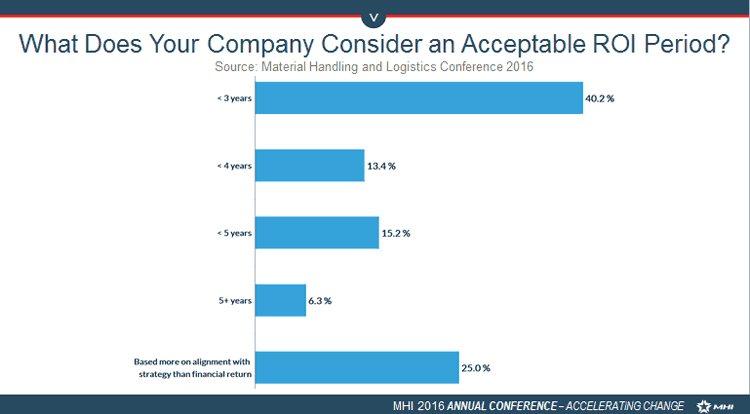What is an acceptable "payback period" for supply chain investments, notably on the technology side?
The payback period of course refers to how long in months or years the savings (or in some cases additional revenues/margin) will deliver back the initial cost of the project. So if, to take a very simple example, the initial investment is $750,000 and the savings are $250,000 per year, the payback period would be three years.
Most larger companies use more sophisticated methods, such as internal rate of return (IRR) compared against the companies "hurdle rate" at the time of the investment (the level of return the IRR must exceed).
But many mid-sized or smaller firms may think in terms of payback period, and even large ones may use it as a quick check on whether a proposed investment passes the initial smell test.
A few weeks ago at Dematic's Material Handling and Logistics Conference, audience members were polled about their companies payback period requirements, as shown the the graphic below:

Source: Dematic
As can be seen, 40% say a three year payback is needed for investment, versus 13.4% and 15.2% for four and even five year paybacks, respectively. 25% said go-no go decisions were based more on alignment with company strategy than financial returns, though in SCDigest's the payback needs to be calculated for all but the most strategic (usually meaning customer facing) programs.
As a note, it is often said European companies invest more readily in materials handling automation because they are generally more willing to accept a longer payback periods than US companies are.
All of this got us wondering, how does payback period relate if at all to internal rate of return? The answer is, it depends on how long the savings from the investment will keep accumulating. Taking our earlier example, if the savings from the investment somehow stopped after that three year payback period, the internal rate of return would be zero, or really slightly negative if you also included the time-value of money.
But what would be the IRR if that $250,000 per year continued on beyond year three? Again, not considering the time value of money the answer is:
4 Years: 12.6%
5 Years: 19.8%
6 Years: 24.3%
7 Years: 27.1%
This was done very simplistically, and the formal calculation within a company would generally be more sophisticated, but this provides a reasonable look at the relationship between payback period and internal rate of return.
Any Feedback on our Supply Chain Graphic of the Week? Let us know your thoughts at the Feedback section below.
Your Comments/Feedback
|